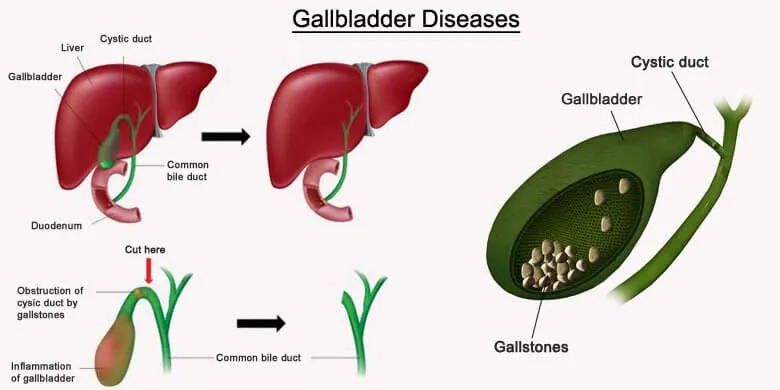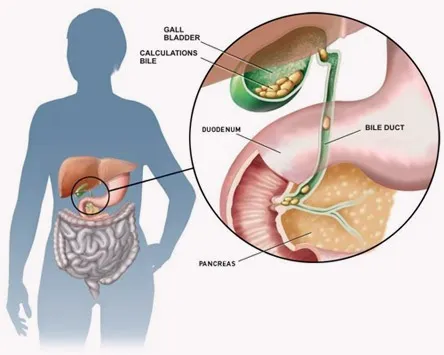Gallbladder Disease with Common Symptoms, Diagnosis and Treatment
What is Gallbladder Disease?
It is not hard to guess that any condition that affects biliary vesicle is a gallbladder disease. Also known as cholecyst or biliary vesicle, gallbladder is a small structure that makes a connection with the liver. The bile duct connects the liver with cholecyst.

The major gallbladder function is to store and concentrate bile juice, coming from the liver. Quite interestingly, the humans can live a normal healthy life without having this structure present in their body. The ailment of the organ is nevertheless very troublesome for the victim.
A number of different gallbladder diseases are known to affect this pear like organ. Some of these abnormalities are mild while others are of serious nature. Some of the common conditions on gallbladder disease list include inflammation of the organ, formation of gallstones, cholesterolosis and gallbladder polyps.
Below is the list of gallbladder diseases along with brief description of each. Here you will also come across the symptoms and common treatment measures for each.
Cholecystitis
Cholecystitis is a gallbladder disease that usually occurs due to the formation of gallstones and the bacterial infection. Certain chemical agents cause irritation which ultimately leads to the inflammatory disorder. In the most of the cases, you can treat such swellings with medicines. However, the more severe symptoms may require the immediate removal of gall bladder through surgery or other treatment measures.
Common Symptoms:
- Pain – The victim experiences severe pain in the abdominal area.
- Fever – There are chances for the patient to suffer from high fever.
- Soreness – Soreness appears in the right part of abdomen.
- Nausea – There is feeling of nausea which may be followed by vomiting.
- Increase in Intensity of Pain – Deep breath can cause increase in the intensity of the pain.
- Pain after Meals – After meals, pain may last for up to six hours.
Diagnosis and Treatment:
The patient history and physical examination can help the doctor in diagnosing the gallbladder disease of cholecystitis. During physical exam, the doctor may put his hand on the right upper abdomen to look for tenderness.
Concerning treatment, the mild swelling and pain in the organ are treatable through medications. But advanced and severe cases require its removal through surgical operation.
Gall Stones
 Gallstone is another condition on the gallbladder disease list. You also call it Cholelithiasis. The common predisposing factor for gall stones is the precipitation of bile in the bladder and the biliary tract. Many of the ingredients of hepatic fluid, like bilirubin, calcium and cholesterol have tendencies for easy precipitation and formation of hard stones in the biliary vesicle.
Gallstone is another condition on the gallbladder disease list. You also call it Cholelithiasis. The common predisposing factor for gall stones is the precipitation of bile in the bladder and the biliary tract. Many of the ingredients of hepatic fluid, like bilirubin, calcium and cholesterol have tendencies for easy precipitation and formation of hard stones in the biliary vesicle.
Common Symptoms:
Usually cholelithiasis is harmless without any painful symptoms. And such a situation poses difficulty in the diagnosis of the disorder. In case the stones cause blockage in the passage of bile, there will arise certain symptoms, including:
- Abdominal Pain: In some cases, severe abdominal pain starts especially after the patient has taken fatty foods.
- Radiating Pain: Usually occurring in the abdominal area, the pain is likely to extend below the right shoulder blade and the patient’s back.
- Effect of Fatty Foods: If the victim eats greasy or fatty foods, the pain may get worsened.
- Effect of Deep Breathing: Deep breathing can also trigger abdominal pain.
- Uneasy Feeling: The patient experiences uneasy feeling in the chest region.
Diagnosis and Treatment:
The patient history and physical examination can help doctor in diagnosing the presence of gallstones. Different tests for the diagnosis of this condition include ultrasound, CAT scan, blood tests, HIDA scan, endoscopic ultrasound, MRCP and ERCP.
The images of different parts of body, through ultrasound, are of great deal of help in detecting stony structures. The combination of ultrasound and endoscopy (i.e. endoscopic ultrasound) is also common. With the help of CAT scan, the cross-section images of body tissues and organs are created.
At the same time, the blood tests are useful to check for the signs of infection or to rule out other conditions. The HIDA scan or cholescintigraphy test help to determine if the contractions of gallbladder are normal.
Through ERCP (Endoscopic Retrograde Cholangiopancreatography), the ducts become visible by dying and then the doctor can remove the gallstones in those ducts. Laparoscopic cholecystectomy and open cholecystectomy are two common treatment measures for gallstones.
Cancer of Gallbladder
It is one of the dangerous gall bladder diseases. Women are more susceptible to this type of cancers than men. On the other hand, most of the cancerous conditions are alarmingly dangerous at the time of diagnosis. The inflammation of the bladder for a longer period of time may result in cancers and the only available treatment option is the removal of this biliary vesicle by means of surgery.
Common Symptoms:
- Itchiness – The suffers complain of the feeling of itchiness.
- Fever – Fever may fluctuate between low and high.
- Bloated Feeling – There is bloated feeling in the abdominal region.
- Pain – Victims experience in the upper right portion of abdomen.
- Weight Loss – The loss of weight occurs due to the loss of appetite.
- Nausea – Usually, there is nausea but it may be followed by vomiting.
- Jaundice – The symptoms of jaundice may appear, such as the yellowing of the whites of eyes and skin.
Diagnosis and Treatment:
The tests that the doctors use to examine gallbladder and other nearby organs can also help in the diagnosis of gallbladder cancer. In this way, the therapists are also able to determine the stage to which the cancer might have progressed.
The common methods of detecting, diagnosing and staging gallbladder cancer include patient history, physical examination, liver function tests, carcinoembryonic antigen assay, CT Scan, CA 19-9 Assay, blood chemistry studies, chest X-ray and ultrasound exam.
After the successful diagnosis of the disease and its appropriate staging, doctors try to remove the organ surgically. And the removal of gallbladder does not make a major difference.


